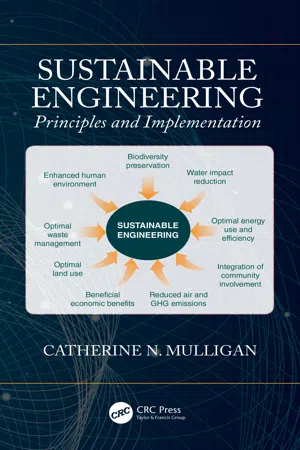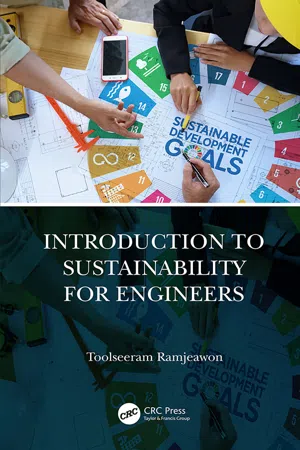Environmental Engineering
Environmental engineering involves the application of scientific and engineering principles to protect and improve the environment. It focuses on addressing issues such as air and water pollution, waste management, and sustainable development. Environmental engineers work to design and implement solutions that minimize the impact of human activities on the natural world.
3 Key excerpts on "Environmental Engineering"
- eBook - ePub
- P.K. Jayasree, K Balan, V Rani(Authors)
- 2021(Publication Date)
- CRC Press(Publisher)
...Air pollution, transport of pollutants, purification of water, treatment of waste water, management of solid state and its treatment, and management of hazardous waste are some of the topics covered by Environmental Engineering. Environmental engineers must actively participate in industrial ecology, reduction of pollution, and green engineering. Environmental Engineering is related to the collection of information and assessing the impact due to some proposed civil engineering constructions like hydro-projects, chemical projects, thermal projects, etc., on the environment. Sanitary engineering is a part of Environmental Engineering nowadays. However, conventionally sanitary engineering did not include management of hazardous waste and works involving environmental remediation which are presently capped under Environmental Engineering. Some alternate terms used for sanitary engineering are environmental health engineering and public health engineering. 1.4.6 Transportation Engineering Transportation engineering is related to the movement of people, goods, and vehicles safely and efficiently without consuming any extra time with the help of different ways of transportation. This includes design, construction, and maintenance of transportation infrastructures like roads, traffic islands, railways, highways, canals, ports, airports, and heavy mass transit. It mainly includes transportation planning, transportation design, traffic engineering, and some concepts of pavement engineering, urban engineering, queuing theory, infrastructure management, and Intelligent Transportation System. The following subbranches are covered under this discipline: Highway engineering : Highway engineering deals with highways, covering the topics of planning, designing, and construction...
- eBook - ePub
Sustainable Engineering
Principles and Implementation
- Catherine Mulligan(Author)
- 2019(Publication Date)
- CRC Press(Publisher)
...Traditional and cultural values must be included. Sustainability aspects should be incorporated at the earliest possible stage and employ applicable standards and criteria. Costs and benefits of environmental protection, ecosystem components, climate change and extreme events, and sustainability should be incorporated in the economic viability of the work. Environmental stewardship and sustainability planning should be over the life cycle for planning and management activities and efficient, sustainable solutions should be employed. A balance between environmental, social, and economic factors should be achieved to contribute to healthy surroundings in the built and natural environment. An open, timely, and transparent engagement process for both external and internal stakeholders should solicit input in and respond to economic, social, and environmental concerns. Regulatory and legal requirements must be met and exceeded by applying best available, economically viable technologies and procedures. In the cases where there are threats of serious or irreversible damage and scientific uncertainty, risk mitigation measures should be implemented in a timely fashion to minimize environmental degradation. Engineers of all disciplines are involved in the development of technologies to improve life but must assure that impacts (social, economic, and environmental) are minimized. For example, Johnston (2016) indicated that process, civil, mechanical, electrical, instrumentation, and control engineers should work together with economists and scientists to ensure sustainable wastewater treatment and management solutions. Conferences such as STS Forum in Japan (held annually), Engineering for Sustainability (held in Denver, CO, February 18–19, 2016), and the 2015 Engineering Triennial Summit of the ICE/ASCE/CSCE held in London, United Kingdom, are excellent examples of efforts to establishing collaborations between various societies. Climate change is also creating challenges...
- eBook - ePub
- Toolseeram Ramjeawon(Author)
- 2020(Publication Date)
- CRC Press(Publisher)
...The natural and man-made world is highly interconnected, so that actions in one sphere can have unintended and unforeseen consequences elsewhere. Engineering solutions have to operate within highly complex systems and engineers need to have a habit of mind that allows them to see the “big picture” and to cope with change and uncertainty. Engineers also work in multidisciplinary teams where they are involved with other specialists and this means that they may or may not have control of, or be solely responsible for, a particular project. However, they should be engaged for preparing and presenting clear justifications to implement more sustainable solutions that serve the public interest. They should strive to understand and manage the environmental aspects of projects that they are involved with and need to learn to engage better with communities...


